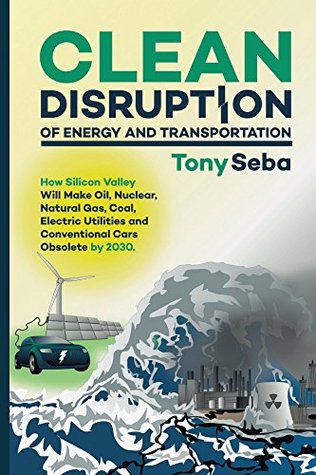More on this book
Community
Kindle Notes & Highlights
by
Tony Seba
Like many information products, it benefits from Moore’s Law
You can’t compete with exponentially improving products
It’s just a matter of time before the disruption happens to your company. This applies inside as well as outside the industry. Ask Nokia and Blackberry.
Large, centralized, top-down, supplier-centric energy is on its way out. It is being replaced by modular, distributed, bottom-up, open, knowledge-based, consumer-centric energy.
The web did not disrupt the newspaper industry because we ran out of paper.
Again, the cell phone industry disrupted landline telephony because mobile phones are a faster, cleaner, cheaper, more compelling way to communicate,
Energy and transportation as we know it today will be history by 2030.
“If you evaluated rooftop solar a year ago, or even three months ago, you are way out of date.”
Solar has arrived. Solar is on the cusp of disrupting the world’s largest industry.
The question is not if but when it will happen.
1.4 GW in the year 2000 to 141 GW at the end of 2013
If you think that any industry can compete with a technology that has improved its cost position relative to yours by more than five thousand times, you’re in denial and bankruptcy looms near.
No such luck. Innovation in the solar photovoltaic business is relentless; competition in PV manufacturing is brutal.
so-called soft costs now account for a higher percentage of total installation costs.
Soft costs include the cost of permits, regulations, taxes, interconnection fees, inspections, and installation.
The decision about switching to solar energy will not be about being green but about saving green (dollars).
On March 26, 2013, the city council of Lancaster approved a change in the zoning laws by which every new home must be built with solar panels.
Molten salt energy storage (MSES), also called “solar salt” batteries, are thermal, not chemistry-based batteries like the Lithium-ion battery that powers electric vehicles such as Tesla’s Model S
You have to admit that building a distributed, over-the-air, bit-based infrastructure is easier than a centralized, pipeline-based, atom-based one.
solar literally went through the roof due to a business model innovation.
PACE (property assessed clean energy)
Re-Volv is a non-profit, community-oriented organization.
they won’t prevent the inevitable disruption.
because it destroys its most lucrative revenue stream: peak pricing.
Power plant operators bid at their marginal cost, that is, at the cash cost to produce their next unit of energy (MWh). The marginal cost is mainly determined by the cost of fuel.
the cost of producing the next unit (MWh) of solar energy is also zero.
For technical reasons, these plants need to keep running whether or not they sell output.
but a centralized generation facility requires an expensive transmission and distribution infrastructure to deliver its power to retail customers.
no matter how subsidized it is. Not gas, not coal, and certainly not nuclear or diesel.
A company that did not even exist ten years before had built the first electric vehicle to ever win this prize.
The electric vehicle will disrupt the gasoline car industry (and with it the oil industry) swiftly and permanently.
The Electric Motor Is Five Times More Energy Efficient
A full 79 percent of petroleum energy used in transportation goes up in smoke
They can make incremental improvements, but the laws of physics stand in their way.
Start by remembering what the electric vehicle does not have: radiators, pistons, an exhaust, a crankshaft, a clutch, pumps, and myriad other thermal engine necessities that waste so much energy
electric motor has an energy conversion efficiency of up to 99.99 percent.
is about ten times cheaper to charge an electric vehicle than fill up an equivalent gasoline vehicle for two reasons:
Electric motors are four to five times more energy-efficient than gasoline vehicles. Gasoline is two to three times more expensive per energy unit than electricity.
The Electric Vehicle Is Ten Times Cheaper to Maintain
oil change every three to five thousand miles.
it doesn’t need any of the parts that have to do with combustion:
The electric vehicle industry has adapted induction power transfer (IPT) so cars can be charged wirelessly without a “typical” charging infrastructure.
The EV Has a Modular Design Architecture
should one of the two motors fail, an electric car does not have to stop running.
Which is worse, “range anxiety” or financial insecurity brought about by high gasoline prices?


